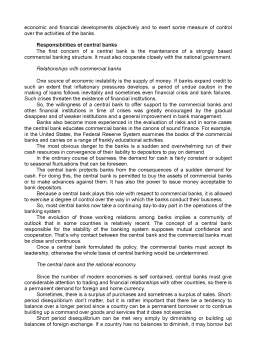Extras din referat
Banks and Banking
The principal types of banking in the modern industrial world are commercial banking and central banking.
A commercial banker is a dealer in money and in substitutes for money, such as checks or bills of exchange.
The banks of the banking business is borrowing from individuals (firms and occasionally governments)- receiving “deposits” from them. With these resources and also with the bank’s own capital, the banker makes loans or extends credit and also invests in securities. The banker makes profit by borrowing at an rate of interest and lending at a higher rate and by charging commissions for services rendered.
A bank must always have cash balances on hand in order to pay its depositors upon demand or when the amounts credited to them become due. It must also keep a proportion of its assets in form that can readily be converted into cash. Only in this way can confidence in the banking system be maintained. Provided it honours its promises, a bank can create credit for use by its customers by issuing additional notes or by making new loans which in their turn become new deposits. The amount of credit may considerably exceed the sums available to it in cash, but the bank is able to do this, only as long as the public believes the bank can and will honour its obligations. The claims against the bank can be transferred by means of checks or other negotiable instruments from one party to another.
These are the essentials of deposit banking as practiced throughout the world today, with the partial exception of socialist-type institutions.
Another type of banking is carried out by central banks, bankers to governments and “lenders of last resort” to commercial banks and other financial institutions. They are often responsible for formulating and implementing monetary and credit policies, usually in cooperation with the government.
In some cases, the US Federal Reserve System have been established specifically to lead or regulate the banking system; the Bank of England have come to perform these functions through a process of evolution.
Finance companies, savings banks, investments banks, trust companies are often called banks, but they don’t perform the banking functions described and are only financial intermediaries, cannot create money, they can lend no more than savers place with them.
I The development of banking system
Banking is known about it prior to the 13th century.
Early “banks” dealt primarily in coin and bullion, their business being money changing and the supplying of foreign and domestic coin. Another group of banking institutions was the merchant bankers, who dealt in goods and in bills of exchange, providing for the remittance of money at distance through one of its agents elsewhere.
Another form of early banking activity was the acceptance of deposits based on oral agreement between the parties whereby the customer would be allowed to overdraw his account.
In the 17th century, English bankers begun to develop a deposit banking business. They dealt in bullion and foreign exchange, acquiring and sorting coin for profit. As a means of attracting coin for sorting, they were prepared to pay a rate of interest.
About the same time, a practice grew up, whereby a customer could arrange for the transfer of part of his credit balance to another party by addressing an order to the banker. This was the origin of modern check. It was only a short step from making a loan in specie or coin, to allowing customers to borrow by check. The customer could overdraw his account at once or up to a specified limit. In the first case, interest was charged on the full amount of the debit, and in the second, the customer paid interest only on the amount actually borrowed.
Another way in which a bank could create claims against itself was by issuing bank notes. The amount depended on the banker’s judgement of the possible demand for specie. The first bank notes issued in Europe were by the Bank of Stockholm in 1661. Nowadays, in most countries the issue of bank-notes has become a prerogative of the Central Bank.
When the check proved to be a convenient mean of payment and the public begun to use check for the larger part of their monetary transactions, banks begun to grant the drawing of checks much in excess of the amount of cash hold, in this way “creating money”, claims that were generally accepted as means of payment. Such money come to be known as “bank money” or “credit”. When a check is drawn, a loan is created but usually every loan so made tends to return to the banking system as a deposit, and so deposits tend to increase for the system as a whole to about the same extent as loans.
The check was defined as a bill of exchange and the early legal recognition of the negotiability of credit instruments. Bill of exchange was one of the most important factors in the development of banking in England.
On the other hand, in continental Europe, limitations on the negotiability of an order of payment presented the extention of deposit banking based on check. Continental countries developed their own system, known as giro payments, whereby transfers were effected on the basis of written instructions to debit the account of the payer and to credit that of the payee.
II The business of banking
The business of banking consists of borrowing and lending. As in other businesses, operations must be based on capital, but banks employ comparatively little of their own capital in relation to the total volume of their transactions. The purpose of capital and reserve accounts is primarily to provide an ultimate cover against losses on loans and instruments. In the United States, capital accounts also have a legal significance, since the laws limit the proportion of its capital, a bank may lend to a single borrower. Similar arrangements exit elsewhere.
Preview document
Conținut arhivă zip
- Banks and Banking.doc





















